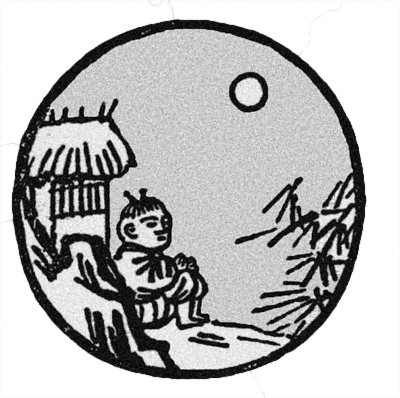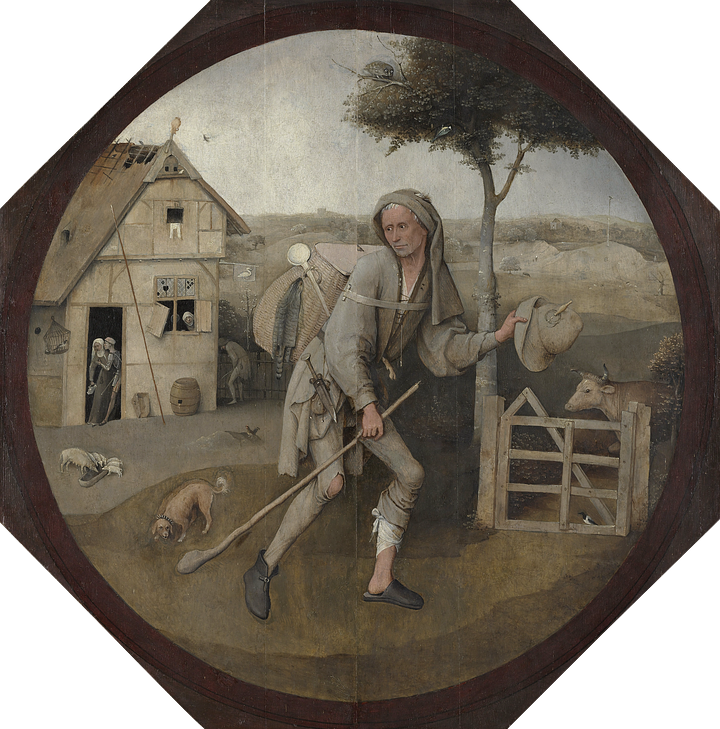The text of this post has been translated from Dutch to English with DeepL. It will be manually edited and streamlined soon.
THE IMAGE of the two trigrams: above Wind, below Earth. A gentle breeze blowing across the earth. She touches everything on the earth, but leaves things as they are. Wind over Earth: the image of Observing. Viewing things as they are and not as you would like them to be.
THE IMAGE of the whole hexagram: an open gate. A gate that offers a view of reality and through which you can perceive. A gate, a window, a keyhole, a gap, a crack in the wall, an opened eye, a viewer, a doorbell camera, a microscope, a periscope. An opening: the image of Observing.
The train passenger watches the landscape pass by through the window. Cows in the meadow, a church tower, a windmill appear suddenly, without notice, and disappear again in a flash. The driver in the front of the locomotive sees these same landscape elements already from afar, and he keeps their approach constantly in sight. While walking or cycling, the passenger would relate to his surroundings in exactly the same way, his sight on the world not restricted to just the sideways oriented train window. The future - that which is coming towards him - is right in front of him and approaching him head-on. The sense of time and of movement and the perception of the environment go hand in hand.
… for I lived like the Puri Indians, of whom it is said that ‘for yesterday, today, and tomorrow they have only one word, and they express the variety of meaning by pointing backward for yesterday forward for tomorrow, and overhead for the passing day.’
Walden - Henry David Thorauu
The driver of the train watches the future thunder straight towards him at 290 kilometres per hour. What he sees, it’s what he gets.
Imagine walking to the end of the last carriage of the moving train and looking through the window of the closed lock door. You will see the opposite of what the driver perceives: The landscape and rails slip into the past at breakneck speed.
While watching the disappearance of rails and landscape you have to stand backwards. When walking and cycling, it is the eyes that connect to what is to come, and it is the back behind which the past slips away. If you had an extra pair of eyes in the back of your head, you could perceive the two temporal movements simultaneously. Then you could experience the movement of the two videos above at the same time.
For advice, we turn to Janus, guardian of time, god with two faces, looking to future and past. Janus oversaw gates, passages and transitions, witness the Latin word for door, ianua. The first day of the month named after Janus marks the transition from the old to the new year. But of course, instead of 1 January, any other day could have been chosen for celebrating this. In fact, any random moment constitutes the transition between 'was' and 'will be', between past and future. Every single moment is a 'now' and is again and again a gateway, a window for transition. A phenomenon that the Puri Indians described by Thoreau indicated by pointing straight above their heads.

The mystery of time has been a subject of contemplation in every culture. The collective assumption of time in the guise of Chronos - moving linearly from past to future and neatly divided into years, hours and seconds - is extremely practical and useful in an efficiency- and production-oriented society. But the staccato ticking clock in no way describes the infinite variation in how a human being actually experiences time.

It is precisely the most obvious that deserves further consideration. A child asks that which adults take for granted and consider trivial. As a child, I asked: How do I know whether my red is the same as your red? Maybe you see it as blue. The question, of course, remained unanswered - and could therefore mature and deepen into: Is my red really red?
When light hits a red car on the streetcorner, only the red rays are reflected into our eyes, and we say ‘red.’ The other rays are absorbed by the car’s paint job. When light hits a blue mailbox, the blue is reflected, and we say 'blue’. The color we see is always the one being reflected, the one that doesn’t stay put and get absorbed. We see the rejected color, and say ‘an apple is red’. But in truth an apple is everything but red.
Diane Ackerman - A Natural History of the Senses


What are the most important prerequisites and requirements for observation and contemplation? Foremost, it is the courage to approach things in order to look at them very closely, without judgement and a preconceived plan. And to take the risk to stand still and allow things, people and feelings to come near you. The essential condition of observing lies in the previous chapter 19. Approaching.
In the keen eye, in for-sightedness and the curious eye, the penetrating gaze and the inquiring eye, there is all a sequel. They all testify to an active mode, a 'looking for'. An assumption that understanding only comes after strenuous effort. The seeker can easily forget to halt for a while. Clear observation and restless searching simply do not go well together.

Giving up excess ambition softens the eyes. Sometimes that takes great disappointment, or exhaustion or loss. Maybe it is just due to getting older that one finally remembers the simple act of sitting on the threshold of one's home. And then to see the things that were always there, but overlooked - because truth couldn’t be so trivial, beauty not so mundane.
The prodigal son's gentle, wistful gaze searches no further. After a turbulent life, after doing everything God forbade, he has returned home. Realising what he missed out on, through all the inner turmoil in life, he is finally at peace with that. His eyes can now see things as they really are and not how he had always wished them to be.


You've seen it for a thousand times, but when you can look again with the eyes of a child, it is fresh and sensationally new. Or, in amazement you really see something for a first time and the bystanders, themselves dulled by the power of habit, suddenly realise how extraordinary life really is. This is shoshin, the beginner's mind, the uninhibited view of a child, the expert having the courage to see with new eyes.
A gate, a window, an opening, a crack - they all offer views and are omnipresent. Sitting at ease, watching with full attention, that makes the real difference. You don't have to go far - the grass is not greener on the other side.
Without going outside,
you may know the whole world.
Without looking through the window,
you may see the ways of heaven.
The farther you go,
the less you know.
Tao Teh Ching 47




The birds are in their trees,
the toast is in the toaster,
and the poets are at their windows.
…
Which window it hardly seems to matter
though many have a favorite,
for there is always something to see-
a bird grasping a thin branch,
the headlight of a taxi rounding a corner,
those two boys in wool caps angling across the street.
…
Just think –
before the invention of the window,
the poets would have had to put on a jacket
and a winter hat to go outside
or remain indoors with only a wall to stare at.Billy Collins
My great-grandfather, whom I still knew as a small boy, used to squat on the threshold of his front door daily and into old age. In this position he watched all the village street life and especially us, the playing children. This fond memory makes the threshold of the front door a revered location to sit and watch. Sitting in the doorway where inner and outer worlds meet.









